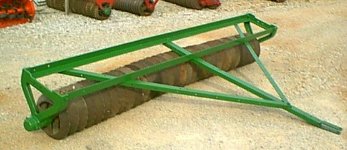I own a Kubota
L2800 HST 4wd tractor that has 23 pto hp and am considering buying a tiller. I think that a 5 ft. unit will work well with my tractor but am also considering a 56' Caroni unit at my local Agri Supply store. I will be using this to plant a 1/4 acre garden plot at my house, and several 1/2 acre sized food plots in the fall.
However, I have never used a tiller to plant food plots. I have always used a disc harrow to break up the soil then I would broadcast the soybeans, wheat, rye, etc. and work them into the soil by lightly discing them into the soil afterwards.
How would you work the seeds into the ground with a tiller? Would you just set it for a very shallow depth and till them in? Would you have to have some type of drag harrow or chain link fence to drag and work them in? What do you tiller owners do?
Also, what are your thoughts on the 56 in. chain driven Caroni tiller (they have them for around $1250). Agri supply also carries a 5ft gear drive "Tillovator" for $1200. Has anyone heard of that brand? All it says on their website is "Tillovator" and the guy on the phone didn't know who made them.


